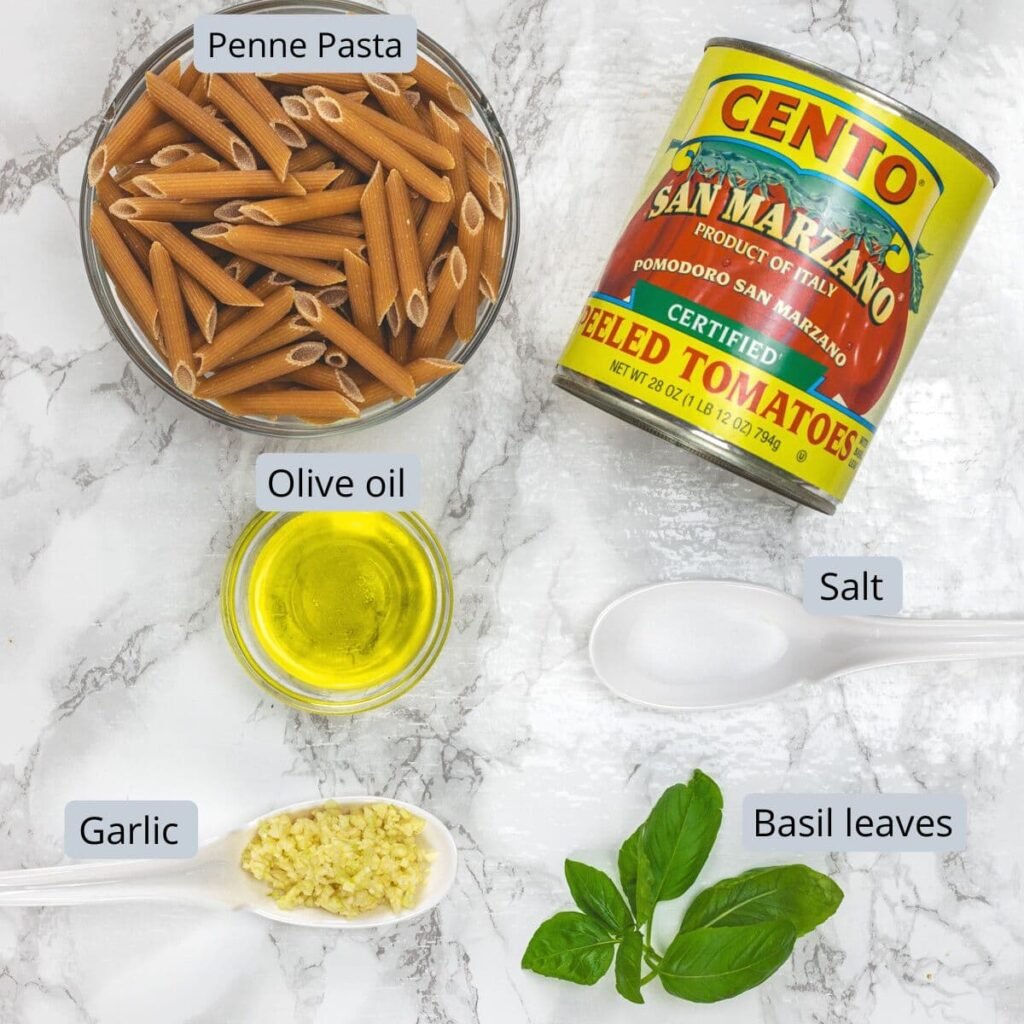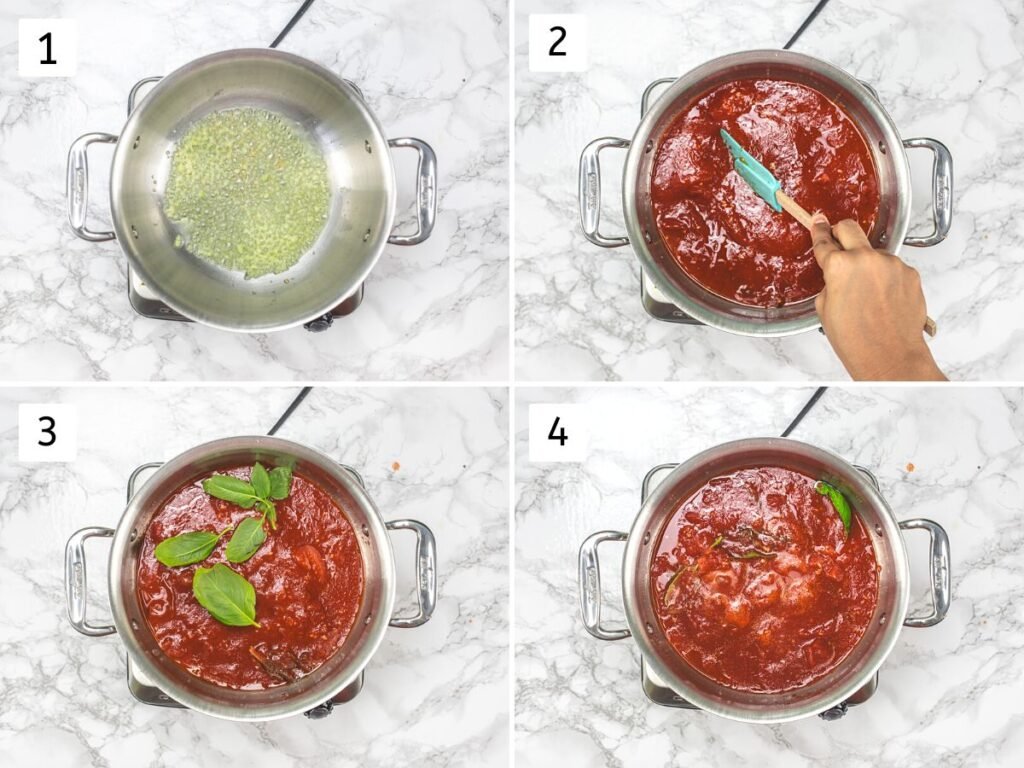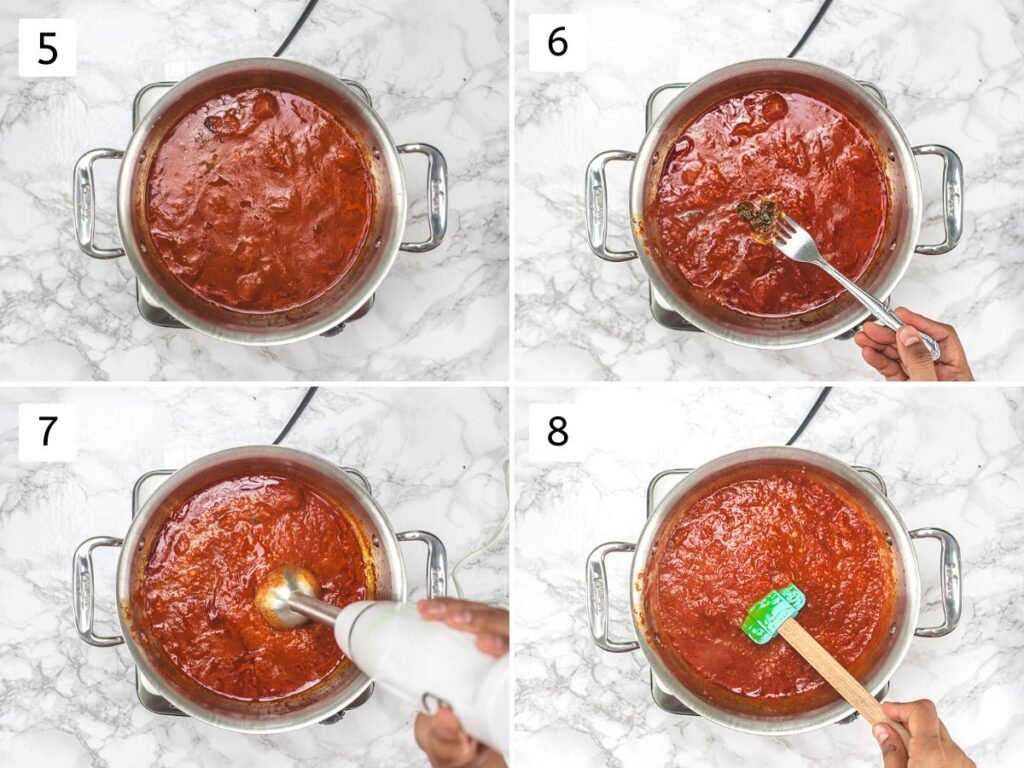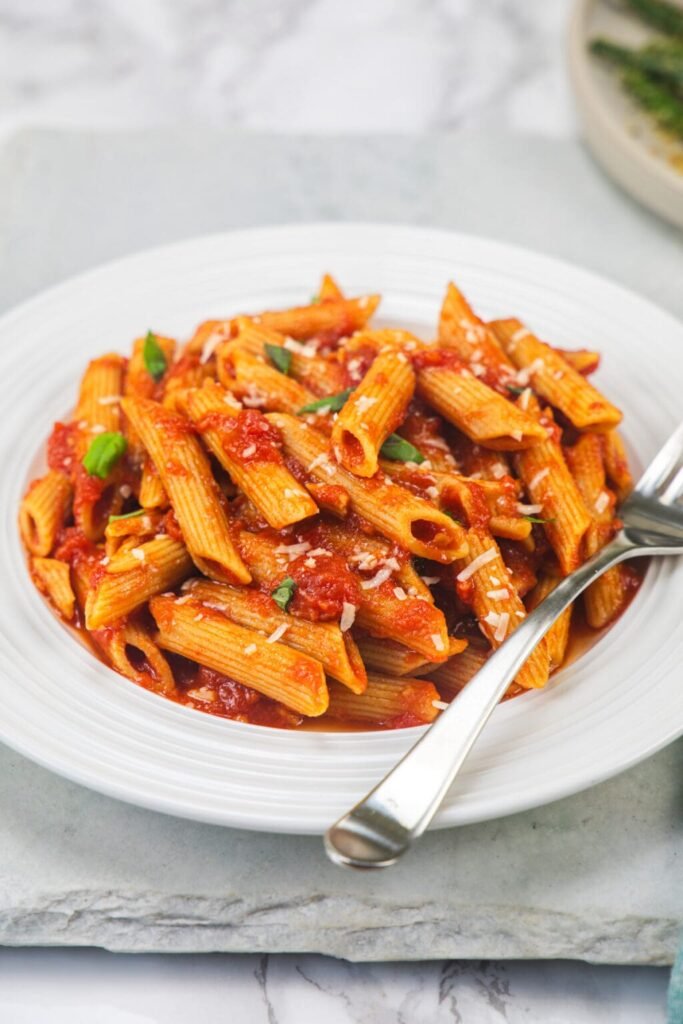Italians celebrate Penne Pomodoro for its simplicity and rich, comforting flavor. Made using just six basic ingredients — penne pasta, ripe tomatoes, garlic, olive oil, fresh basil, and salt — this recipe brings out the true essence of Italian home cooking. It’s the kind of comforting, no-fuss meal that can easily become a go-to favorite for busy weeknights or relaxed family dinners.

What makes Penne Pomodoro truly special is its fresh tomato-based sauce, known as sugo al pomodoro. This sauce forms the heart of many Italian dishes. Its naturally sweet and tangy tomato flavor shines through, enhanced by the aroma of sautéed garlic and the vibrant freshness of basil leaves. The sauce lightly coats the al dente penne, allowing every bite to deliver a burst of Mediterranean flavor.
The beauty of this Penne Pomodoro dish lies in its simplicity — no cream, no cheese, just pure and honest ingredients that speak for themselves. It’s wholesome, vegetarian-friendly, and incredibly easy to prepare in under 30 minutes, making it ideal for both beginners and seasoned cooks alike.
Penne Pomodoro offers quick, flavorful comfort—add chili flakes, pair with garlic bread or salad, and savor Italian simplicity.
What is Pomodoro Sauce?
Pomodoro sauce is a classic, minimalist tomato-based sauce that serves as the heart of many traditional Italian pasta recipes. The term “Pomodoro” originates from Italian, meaning “golden apple,” which reflects the early use of yellow or golden-hued tomatoes when this sauce was first developed. Today, however, vibrant red, sun-ripened tomatoes are the star ingredient, celebrated for their natural sweetness, slight acidity, and rich, juicy flavor.
Pomodoro sauce stands out for its simplicity, using just tomatoes, garlic, olive oil, basil, and salt—pure, fresh flavor.
The tomatoes are gently simmered with garlic in olive oil until they break down into a soft, luscious sauce. A touch of salt enhances the flavor, while fresh basil leaves add a delicate herbal note that complements the tang of the tomatoes. Some versions of the sauce are left slightly chunky, while others are blended for a smooth, velvety texture — both are equally delicious and depend entirely on personal preference.
Pomodoro sauce is beloved for its versatility and ease. It pairs beautifully with a wide variety of pasta shapes — from penne and spaghetti to gnocchi and fusilli — and is a wonderful base for adding vegetables, proteins, or even a sprinkle of cheese, if desired. Light, clean, and incredibly satisfying, Pomodoro sauce is a shining example of how Italian cuisine uses simple, quality ingredients to create something truly flavorful and comforting.
Difference Between Pomodoro Sauce And Marinara Sauce:
- No Onion in Pomodoro: A key difference between pomodoro and marinara sauce lies in the use of onion. Traditional pomodoro sauce skips onions altogether, focusing solely on the natural flavors of ripe tomatoes. This absence helps highlight the freshness and slight tang of the tomatoes without distraction, resulting in a lighter and purer taste.
- Simple Seasoning vs. Bold Flavors: Pomodoro sauce embraces simplicity. It is typically seasoned only with salt and perhaps a few fresh basil leaves, letting the tomatoes take center stage. On the other hand, marinara sauce includes a medley of dried herbs and spices such as oregano, chili flakes, bay leaf, and sometimes garlic and onion. These extra ingredients give marinara sauce a deeper, more layered flavor, offering boldness that contrasts with the gentle and refined taste of pomodoro.
- Texture and Consistency: Another noticeable difference is in the texture. Pomodoro sauce typically has a rich, smooth texture and is often blended into a silky, velvety consistency that clings beautifully to pasta. This allows it to coat pasta like penne, spaghetti, or rigatoni beautifully. Marinara, however, tends to be thinner and chunkier due to the inclusion of diced tomatoes and other vegetables or aromatics. Its consistency makes it versatile for dipping, pizza bases, or quick pasta meals.
- Conclusion: In summary, pomodoro sauce is about elegance in simplicity—with no onions, minimal seasoning, and a thick, smooth texture. Marinara brings in bolder herbs and spices with a rustic, chunkier consistency. Each has its place depending on your taste preference and the dish you’re preparing.
Ingredient Notes For Penne Pomodoro:

- Dry Pasta (Penne): Penne is a classic choice for this recipe—and for good reason. The tube-like shape with ridged surfaces allows the thick pomodoro sauce to cling beautifully, ensuring that every bite is loaded with flavor. Its hollow center also holds some of the sauce, making each forkful more satisfying. While penne works wonderfully, feel free to use any pasta shape of your choice—fusilli, rigatoni, or spaghetti all pair well with this simple yet bold sauce.
- San Marzano Tomatoes: The heart of a great Pomodoro lies in the tomatoes. That’s why I opt for whole, peeled San Marzano tomatoes, preferably canned. Grown in the volcanic soil of Italy, they are naturally sweet, low in acidity, and deliver a deep, rich tomato flavor that elevates the dish to authentic Italian standards. If unavailable, use the ripest, high-quality canned tomatoes you can find.
- Olive Oil: Use good-quality extra virgin olive oil for the best results. It forms the flavor base of the sauce and adds a smooth richness that complements the tomatoes perfectly. Avoid using other oils, as they can alter the flavor profile.
- Garlic: Freshly minced garlic infuses the olive oil with its pungent, savory aroma, laying the perfect foundation for the sauce. If you have fresh garlic on hand, it’s always the best option for authentic flavor and aroma. However, if you’re short on time or ingredients, pre-minced garlic from a jar can be a convenient substitute.
- Fresh Basil Leaves: Basil adds an herbal brightness and subtle sweetness. Fresh leaves, including the tender stems, are best. If fresh basil isn’t on hand, substitute with a pinch of dried basil for a gentler flavor.
- Salt: Just a dash helps balance the tomato’s sweetness and enhances the dish’s overall taste.
How To Make Penne Pomodoro?
Cook the penne pasta in salted boiling water until al dente, following the package directions. Be sure not to overcook—al dente pasta holds its shape and gives the perfect bite. While the pasta is cooking, start preparing the fresh Pomodoro sauce.
1) Sauté the Garlic in Olive Oil:
Heat a good amount of extra virgin olive oil in a large, sturdy pan or deep skillet over medium flame. Once hot, add the freshly minced garlic. Sauté for about 30–40 seconds or until the raw aroma fades and the garlic turns light golden, releasing its fragrance.
2) Add the Tomatoes:
Pour in the canned San Marzano peeled tomatoes. Use a wooden spatula or the back of a spoon to gently crush and break them apart, releasing all the rich juices. This step promotes even cooking of the sauce and accelerates the process of thickening, allowing flavors to develop more efficiently.
3) Add Basil for Flavor:
Toss in a few fresh basil leaves along with the stalks. These will slowly infuse the simmering sauce with a delicate, herbal aroma that enhances the overall taste.
4) Simmer the Sauce:
Lower the heat and allow the sauce to simmer gently for 15 to 20 minutes. Keep the pan partially covered with a lid to prevent tomato splatters while allowing steam to escape, helping the sauce reduce and concentrate.

5) Check for Doneness:
You’ll know the sauce is ready when you see the olive oil start to float on the surface and the tomatoes have fully broken down into a rich, cohesive mixture.
6) Remove Basil Stalks:
Gently lift out and discard the basil leaves and stems from the sauce, as they’ve already infused it with their aromatic flavor.
7 & 8) Blend for Texture:
Using an immersion blender (hand blender), pulse the sauce briefly to create a slightly chunky, rustic texture. Avoid pureeing it completely—you want bits of tomato for body and character.

9) Combine with Pasta:
Once the penne cooks, drain it well and immediately transfer it to the bubbling sauce. Let the pasta absorb the rich tomato flavors, then gently toss until each piece gets evenly coated with the velvety tomato blend.
10) Garnish and Serve:
Serve hot with chopped basil, grated Parmesan, and garlic bread or salad for a comforting Italian meal.

Tips For Penne Pomodoro Recipe:
1. Salt the Water After It Boils
Add salt after water boils—it dissolves faster. Contrary to myth, salt slightly delays boiling by raising the boiling point.
2. Follow Package Timing – But Taste Test!
Check pasta pack time, start tasting at 8 minutes for al dente, and adjust by a minute if needed.
3. Simmer the Pomodoro Sauce for Deep Flavor
Don’t rush the sauce. Allow it to gently simmer, partially covered, for at least 15 to 20 minutes. This slow cooking process helps break down the tomatoes, thicken the sauce, and build a deep, well-rounded flavor profile that clings beautifully to your penne.
4. Add a Touch of Heat (Optional)
For a mild kick, stir in a pinch of red chili flakes while the sauce simmers. This doesn’t overpower the natural sweetness of the tomatoes or the fragrance of the basil but adds just enough warmth to elevate the flavor without making the dish spicy.

Serving Ideas & Variations:
- Parmesan Cheese: Top off your Penne Pomodoro with a generous shower of freshly grated Parmesan cheese just before serving. The sharp, salty, and slightly nutty flavor of the cheese perfectly complements the rich tomato sauce. For an extra indulgent touch, use Parmigiano-Reggiano and grate it just before serving to preserve its aroma and flavor.
- Garlic Bread: Pair your Penne Pomodoro pasta with warm, crusty garlic bread. Slice a baguette or Italian loaf, spread with a mix of butter, minced garlic, and parsley, then toast or bake until golden. Its crunch and bold garlic notes complement the tangy, velvety Penne Pomodoro sauce beautifully.
- Grilled or Roasted Vegetables: Add roasted veggies like zucchini or peppers for extra flavor, texture, and nutrition in your Penne Pomodoro. These veggies add a smoky depth and subtle sweetness to the dish.
- Arugula or Spinach: Add a handful of fresh baby spinach or peppery arugula to the sauce in the last minute of simmering. The warmth of the sauce gently wilts the greens, bringing a fresh flavor and vibrant color to the dish. This not only makes the dish more vibrant but also adds nutritional benefits without overwhelming the delicate flavor of the tomatoes.
